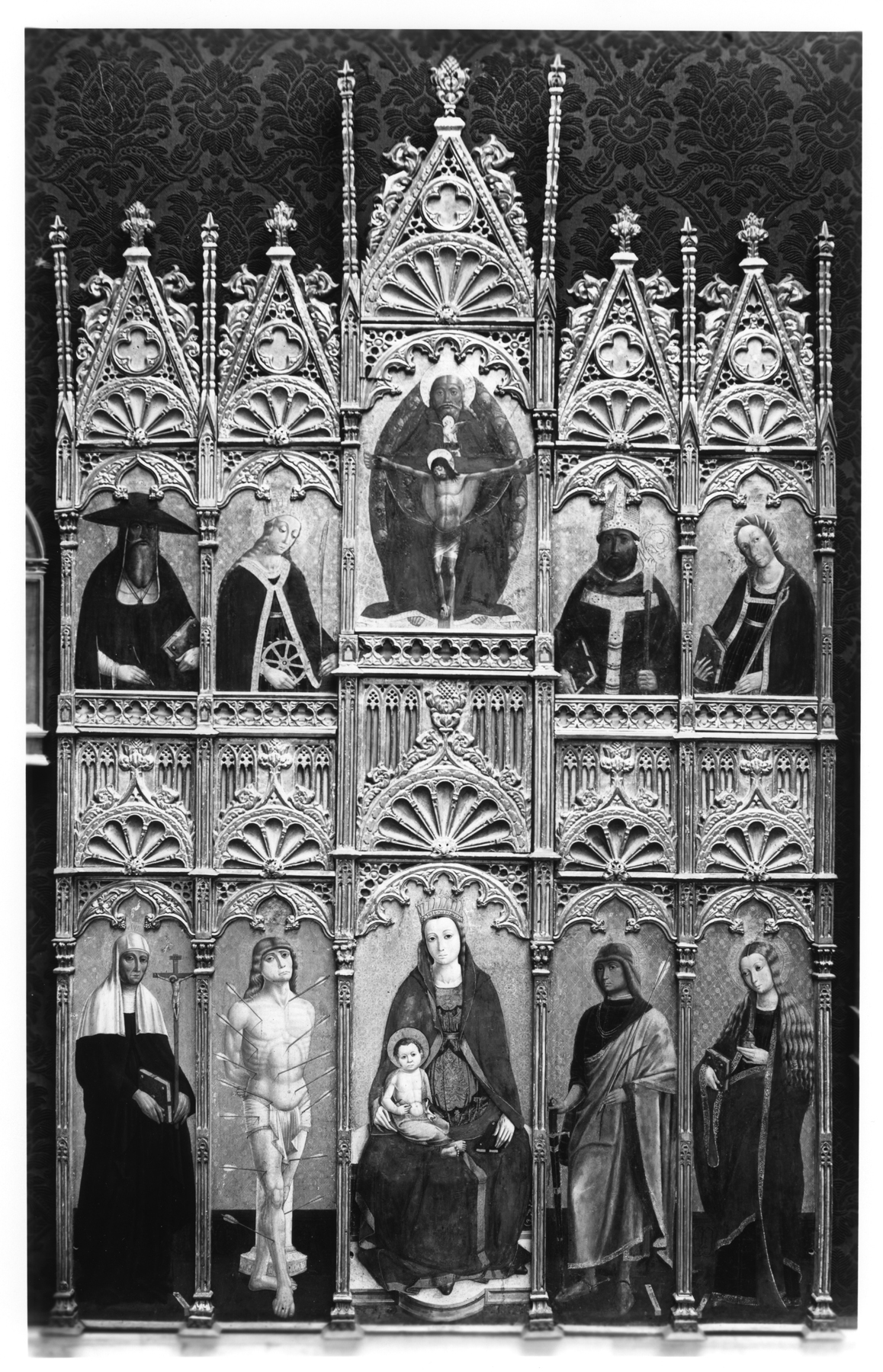Madonna and Child, the Trinity, and Saints
(Renaissance Europe )
This massive altarpiece—intact but unfortunately much damaged—comprises ten panels arranged in two registers. In each panel the figures silhouetted against a background of elaborately tooled gold leaf, which would have flickered in the candlelight of the dimly lit church where the painting was originally installed. Such effects were intended to enhance the illusion that the worshipper was witnessing an assemblage of holy figures in a celestial realm.
On the lower level is the Madonna, enthroned and crowned as Queen of Heaven, supporting the Christ Child on her lap and flanked by (left to right) Saints Clare, Sebastian, an anonymous saint holding a sword and arrow, and Mary Magdalen. On the upper level is the Trinity—represented as God the Father holding the crucified Christ and the Holy Spirit—flanked by (left to right) half-length images of Saints Jerome, Catherine, an anonymous bishop saint, and Saint Apollonia.
The two-tiered format, gold ground, and stylized figures, with their wide eyes and immobile features, are typical of traditional altarpieces produced in the late 1400s in the northernmost parts of Italy near the Alps. This impressive, complete example was produced in 1494 in the region of Piedmont, not far from the French border, by the artist Manfredino Bosilio. It is notably the artist’s only painting in an American museum.
Inscription
Provenance
Provenance (from the French provenir, 'to come from/forth') is the chronology of the ownership, custody, or location of a historical object. Learn more about provenance at the Walters.
Church of Santa Maria delle Ghiare, Pozzolo Formigaro, from 1494 until 1882. Don Marcello Massarenti Collection, Rome [date and mode of acquisition unknown] [1897 catalogue: no. 76, as Tuscan School, early 15th century]; Henry Walters, Baltimore, 1902, by purchase; Walters Art Museum, 1931, by bequest.
Exhibitions
| 1996 | To Arrest the Ravages of Time: Caring for Art at the Walters. The Walters Art Gallery, Baltimore. |
Conservation
| Date | Description | Narrative |
|---|---|---|
| 1/1/1900 | Examination | examined for condition |
| 11/4/1937 | Treatment | repaired |
| 11/4/1937 | Treatment | cleaned; examined for condition; repaired |
| 7/1/1957 | Treatment | cleaned; re-housed |
| 7/7/1966 | Treatment | repaired; other |
| 7/7/1966 | Treatment | examined for condition; repaired |
| 8/24/1966 | Treatment | repaired; other |
| 8/24/1966 | Treatment | examined for condition; repaired |
| 8/25/1966 | Treatment | repaired; other |
| 8/25/1966 | Treatment | examined for condition; repaired |
| 8/27/1966 | Treatment | repaired; other |
| 8/27/1966 | Treatment | examined for condition; repaired |
| 5/8/1996 | Treatment | cleaned |
Geographies
Italy, Piedmont
(Place of Origin)
Italy, Liguria (Place of Origin)
Measurements
H with frame: 153 15/16 x W: 91 7/16 in. (391 x 232.3 cm); Saints Jerome and Monica panel H: 128 1/8 x W: 16 3/4 x D: 1 in. (325.5 x 42.5 x 2.6 cm); Saints Catherine and Sebastian panel H: 128 1/8 x W: 16 3/4 x D: 1 1/8 in. (325.5 x 42.5 x 2.8 cm); Madonna and Child and Trinity panel H: 146 5/8 x W: 22 7/16 x D: 1 5/16 in. (372.5 x 57 x 3.4 cm); Bishop and Saint Sebastian panel H: 127 13/16 x W: 16 9/16 x D: 1 1/4 in. (324.7 x 42 x 3.2 cm); Saints Apollonia and Clare panels H including added members: 127 7/8 x W: 16 5/16 x Approx. D: 1 in. (324.8 x 41.5 x 2.5 cm)
Credit Line
Acquired by Henry Walters with the Massarenti Collection, 1902
Location in Museum
Not on view
Accession Number
In libraries, galleries, museums, and archives, an accession number is a unique identifier assigned to each object in the collection.
In libraries, galleries, museums, and archives, an accession number is a unique identifier assigned to each object in the collection.
37.636


